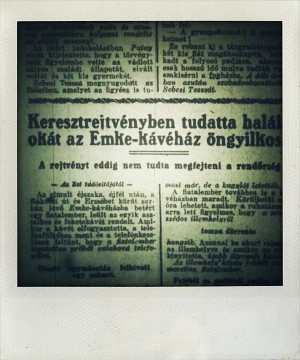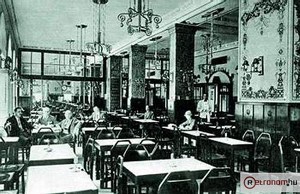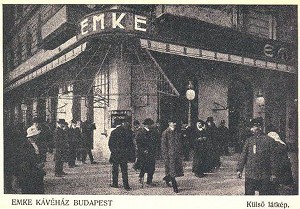Several years ago, I noted here a long-standing story about a 1926 Budapest waiter who (allegedly) killed himself, leaving a suicide note in the form of a crossword. I wondered whether it was an urban legend, or (if it were to prove to be true) whether the crossword might have been printed in a newspaper of the day. But with only a few words of tourist Hungarian to work with, I didn’t really stand a chance in the Hungarian archives.
Well, now Hungarian urban legend-hunter Marinov Iván has eagerly grabbed the baton, and hurdled his way along miles of microfilm in the newspaper archives in search of the truth. As a result, his Hungarian urban legend blog today revealed that this was indeed a real story. According to the 4th March 1926 edition of Az Est, what happened was this (forgive my rough and ready translation / paraphrasing)…
Just after (?) midnight, a man had come into the well-known Emke kávéház [Café Emke] on near the corner of Rákóczi út [Rákóczi Way] and Erzsébet körút [Elizabeth Boulevard]. After having a coffee, he repeatedly tried to call a number using the cafe’s telephone, but without success. About an hour later, the Emke’s cloakroom attendant heard a bang from a toilet: and when she opened the door, she heard a second bang. Inside, she found a young man lying on the floor with a pistol in his hand, and with blood gushing from his head and chest.
Once the ambulance and police arrived, the man’s identity was found to be Antal Gyula [Julius Anthony] of Csengery utca 3 [#3 Csengery Street]. In his pocket there was [- indeed! -] a suicide note containing a crossword. It subsequently turned out that he had lived in “misery and unemployment” for some time, and had been evicted from his apartment at the start of the month, having failed to pay his rent. But as far as his note went, the Est article concluded “A bonyolult keresztrejtvényt azonban eddig még nem sikerült megfejteni“, which I read as “the complexity of the crossword means that it has not yet been deciphered“.
So… what happened next? Iván followed up by looking in lots of other Hungarian newspapers from that year, but they all reported essentially the same bare facts, with only the Pest Newsletter adding that the man was 25 years old, and that the riddle had been “taken to police committee headquarters”. He speculates that had it might have had received more coverage had the man’s job been of higher status than a waiter: sadly, Budapest has long been (and remains to the present day, I believe) a suicide ‘hotspot’, so many other pages of those same newspapers would have contained stories of the same tragic ilk.
Ultimately, Iván failed to find any further references to the story in the newspaper archives, and so it is there that he stopped. Perhaps someone else will now pick up this baton and carry it yet further… perhaps we shall yet get to see Antal’s infamous (but tragically real) crossword!
PS: an Internet search revealed an evocative description of Café Emke in December 1945 in Sándor Márai’s autobiographical “Memoir of Hungary (1944-1948)” (pp.198-205).



Does Ivan know of any social clubs or “senior centers” where possibly someone could help solve the crossword puzzle? Yes, I do understand that it is a very old puzzle, but you’d be surprised to find how many old-timers still plug away at puzzles — any puzzles!
:-}
I would be very glad to assist you solving the puzzle – as a native hungarian speaker. Btw I don’t think so u need to be kind of old to solve crosswords – they are quite popular even today.
od: thank you very much for offering! However, the puzzle we need to solve first is to find a copy of the crossword… 🙁
How awful. I have heard cases that are similar to this. An (od) what do you mean old lol. I love to do crossword puzzles in the newspapers, newsletters, mags etc. I have done them since my early teens. Indeed, its just something I enjoy doing. Historically, 1920s was a decade which involved depression. This moody era included the USA as well. Find the crossword and I will try to help you solve it. Do any of you remember the record , that when played or heard was said to have caused multiple suicides. The song was banned from the US for decades. Very interesting, although those times and depressed mood can be attributed to warfare too.
Unfortunately–at least according to my (admittedly amateur) research–it seems that the puzzle itself was taken into the custody of the police and never seen again. I would imagine it was lost in the chaos and upheaval of Europe over the next few years. Who knows though. Maybe someday a historian will open an old file cabinet and stumble across it.